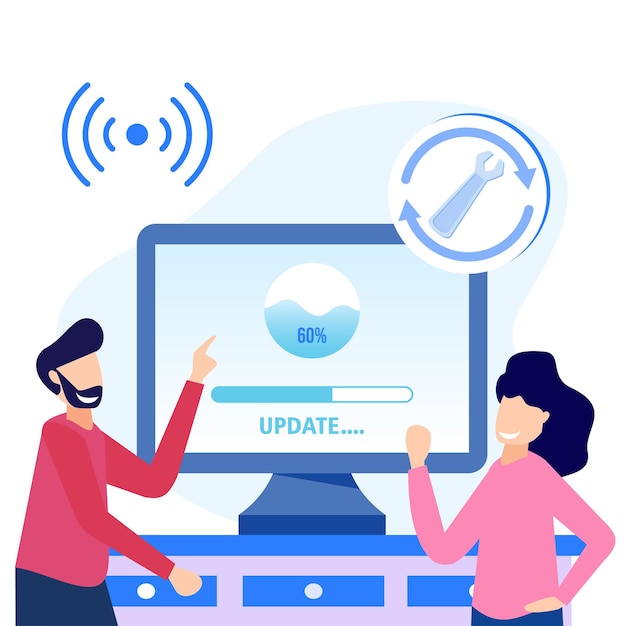An Internet Protocol address (IP) uniquely identifies each device connected to the Internet. Computers connected to the Internet share information with a particular location using IP addresses.
An IP address has two distinct versions. The older of the two Internet Protocol versions (IPv4) can hold up to 4 billion IP addresses and assigns an address to all computers.
There are several different types of IP addresses, including public, private, static, and dynamic IP addresses.
There are two IP address standards: IPV4 and IPV6. The older IPV4 addresses, which have a 4 billion IP address space, are given to all machines. But in addition to PCs, IPV6 attracts a new class of devices because it can support trillions of IP addresses. There are several types of IP addresses, including static, dynamic, private, and public.
Each device is equipped with IP addresses and an active internet connection. An IP address allows for efficient data transmission between two connected devices, allowing different machines to communicate with each other.
In this blog, we will discuss IP addresses. So, let’s get started.
What is an IP Address?
Every device connected to an internet connection has an identifier. IP addresses serve as the numerical addresses that identify the specific piece of hardware connected to the internet.
IP addresses have two common versions: IPV4 and IPV6. IPV4 is 32 bits in size and contains 4,294,967,296 IPV4 addresses. IPV6 is 128 bits in length and includes 340,282,366,920,938,463,463,374,607,431,768,211,456 IPV6 addresses.
A bit is a digit in the binary number system, which is the basic unit for storing information. Not every IP address belongs to the IPV4 or IPV6 category and cannot be assigned to the machines and devices that access the Internet. Network Installation Services ensure the proper configuration and assignment of IP addresses to allow for unique identification and establish connections to the destination.
The whole range of IP addresses can range from 0.0.0.0 to 255.255.255.255. With the correct mathematics assignment of IP addresses, a unique identification can be made to make a connection to the destination.
Types of IP Addresses
- Public IP Address:
A public IP address applies to the main device which people use to connect their home network to their internet service provider (ISP). In various cases, this will be their router. All devices connected to a router communicate with other IP addresses using the router’s IP address.
- Private IP Address:
A private IP address is being assigned in an office by Internet Service P (ISP). The office router manages the private IP addresses of the devices that connect to it from within the local network. Thus, the router maps a network device from its private IP address to a public IP address.
- Static IP Address:
All public and private IP addresses are defined as static or dynamic. A static IP address is one that a person manually configures and fixes to their device’s network. It can’t be changed automatically. An internet service provider (ISP) might assign a static IP address to a user account. The same IP address shall be assigned to that particular user for each session.
- Dynamic IP Address:
When a router is set up, a dynamic IP address is automatically assigned to a network. The Dynamic Host Configuration Protocol (DHCP) distributes this dynamic set of IP addresses. The DHCP can be the router that provides IP addresses to networks across an organization.
Why IP Address is Important?
An IP address is a unique identifier that is assigned to every device that is connected to the Internet. It allows devices to communicate with each other.
An IP address is crucial for communicating with each other over the local area networks. IP addresses are used for the following purposes:
- Identifying Devices: IP addresses uniquely identify each device connected to a network.
- Routing Data: IP addresses specify where the data should be sent and allow data packets to be routed to their intended destination.
- Identifying Intruders: IP addresses are used to identify intruders on a network.
Most of the homes have a dynamic IP address. This is because it is cost-effective for ISPs to assign dynamic IP addresses. However, static IP addresses are often required for various applications, such as web hosting.
Network Prefixes
You can take IP addresses from the IPv4 or the IPv6 section and then divide them into two parts: a network section and a host section. The network section defines a particular network, and the host section identifies a specific node on the local area network.
Allocation
IP addresses are assigned to networks in different blocks. The size of the block assigned is written after an (/) oblique, which states the number of IP addresses stored in that block. Let’s say, for example, if an Internet Service Provider (ISP) is assigned /16, they will receive around 64,000 IPv4 addresses. A /26 network provides 64 IPV4 addresses. The lower the number after an oblique (/), the more addressed it is contained in that block.
IP Addresses Classes:
Some of the IP addresses are reserved by the Internet Assigned Numbers Authority (IANA). These are generally reserved for networks that carry a particular purpose on the TCP/IP, which is to interconnect devices. Typically, there are four types of IP addresses:
- 0.0.0.0: This is IPv4, which is a default network. It is a non-routable network address designed as an invalid, non-applicable, or unknown network target.
- 127.0.0.1: This is known as the loopback address, which a computer uses to identify itself regardless of whether it has been assigned an IP address.
- 169.254.0.1 to 169.254.254.254: This is a range of IP addresses that are automatically assigned if a computer is unsuccessful in an attempt to receive an address from the DHCP.
- 255.255.255.255: This address is dedicated to messages that need to be forwarded to each computer on a broadcast network.
A subnetwork is a small computer that networks that connects to a bigger network through a router. You can assign a subnet to its IP address system so that all the devices connecting to it can communicate with each other without having to send data through a wider network.
The router on a TCP/IP network can be configured to ensure that it recognizes subnets and then routes the traffic onto the appropriate network. IP addresses are reserved for:
-
- Class A: IP addresses between 10.0.0.0 and 10.255.255.255
- Class B: IP addresses between 172.16.0.0 and 172.31.255.255
- Class C: IP addresses between 192.186.0.0 and 192.168.255.255
- Class D or multicast: IP addresses between 224.0.0.0 and 239.255.255.255
- Class E: IP addresses between 240.0.0.0 and 254.255.255.254
IP addresses are classified under Class A, Class B, and Class C and are most commonly used in the generation of subnets. Addresses within the multicast have specific rules outlined in the Internet Engineering Task Force (IETF) guidelines. In contrast, the release of Class E addresses for public use was the cause of plenty of debate before the IPv6 standards were introduced.
IPV4 V/S IPV6
IPV4 has not been able to cope with the huge explosion in the quantity and range of devices used beyond simple desktops, mobile phones, or laptops. The current IP address format could not manage the number of IP addresses that were being created.
To address this issue, technology experts introduced IPV6. This new standard operates in hexadecimal format, allowing billions of unique IP addresses to be created. As a result, the IPV4 system supports up to around 4.3 billion unique numbers, but an alternative has replaced it, offering unlimited IP addresses.
This is because an IPV6 address consists of eight groups, each containing four hexadecimal digits. It uses 16 distinct symbols, 0 to 9, followed by A to F, to represent values of 10 to 15.
How IP Address Change?
One of the most straightforward ways to do this is by adjusting your device’s settings. This only works if your network has an available address to which you can change your present IP address. In addition, the new IP address will still be tied to your local network, and thus, it can be geo-tracked to your approximate location, just like the old one.

How to Change Your IP Address on Windows Manually?
- Click on the start menu.
- Open control panel.
- Click on network and sharing center.
- Click on Change adapter settings.
- Right-click on the local area connection.
- Click on properties.
- Select TCP/IPv4.
- Click on properties.
- Click on the use the following IP address.
- Insert the IP address and then click on Ok.
How to Change Your IP Address on Mac Manually?
- Go to system settings.
- Click on Network.
- Click on WIFI.
- Click on Details.
- Click on TCP/IP.
- From the drop-down menu, click Manually under Configure IPv4.
- Insert your IP address.
How do you manually change the IP address on your router?
- Turn off your router.
- Turn it back on the next day.
- Visit the administrative interface and reconnect to your ISP.
Key Takeaways:
An IP address refers to the numeric label that the internet assigns to devices for communication with each other.
There are two types of IP addresses on the Internet:
- IPV4: There are over 4.3 billion distinct IP addresses available. IPv4 addresses have mostly run out due to the rapid increase in the number of devices connected to the internet.
- IPV6: IPv6 provides a much bigger address space of 340 long-scale addresses, which was designed to overcome the shortcomings of IPv4. This basically guarantees that, despite the quick growth of IoT devices, smart technologies, and other internet-connected systems, the world will not run out of IP addresses.
Though IPv4 still carries certain systems on its shoulders due to legacy support, IPv6 adoption continues to grow, ensuring the scalability and sustainability of the internet for the foreseeable future.





0 Comments